Un-busy yourself even more during the holidays
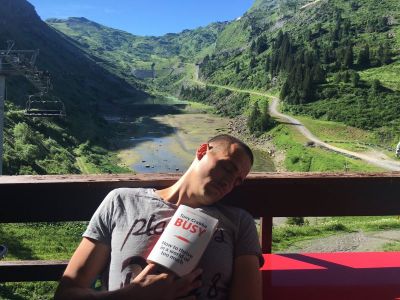
We’re on holiday for two weeks in the French Alps at 1800 metres and looking out over a little lake and a mountain valley. Our only goal here is to make a 2 to 3 hour hike every day, eat well (this is France!), sleep long nights, watch some Netflix (if the internet allows), read and think. Think? Yes, THINK! Work and life in general was quite challenging since last January and I have been very busy. Too busy to properly think. Too busy to binge-watch or binge-read anything remotely interesting. Too busy not to talk to my partner for a couple of hours but just hanging out together - waking up slowly in the morning, enjoying the sun or walking in nature.
Everyone is busy these days. And if you say you are, others will say they are SUPER-busy. Busier than you, they mean, I guess. Don’t get me wrong, I don’t mind being busy. I have an active nature and I like to ‘do’ things. Whether work (had so many diverse and cool assignments over the last months, working with inspiring people), family, friends, sports or house & garden matters. But sometimes it’s all a bit much and I feel ‘it’ pushing down on me like a heavy weight. So I make to-do lists and work my way through them. Once it’s on the list, it all feels like stuff you HAVE to do – and in struggling through it all, you forget to enjoy what you’re doing, celebrate small victories, have a laugh or pat yourself on the back. Sound familiar? That is why Tony Crabbe’s book, simply called ‘Busy’, caught my eye. A ‘life-changing’ self-help book, so the cover promised. Just what I needed for my holidays. Bring it on.
Tony is a psychologist and works in business (we have that in common), but I never thought at the start of the book I would be so taken by it. It’s chock-a-block full of tips & tricks, examples and studies around being busy, recognizing it and changing it. Most of the studies and anecdotes Tony describes I already heard or read before from all kind of other self-help attempts. But he brings them relevantly really together around the topic of being busy and therefore nails the issue in my opinion. And he has a clear opinion about what busy is. Being busy all the time is ‘out’, not interesting at all and leads to nothing sustainable in your life. What to do? Learn to master your business better, differentiate yourself from others on strategically interesting aspects and engage with the people and activities around you!
It’s impossible to share the many tips & tricks mentioned in the book and you will have to find the time (ha!) to read it yourself to figure out what would work for you. But I do want to share the model Tony explains about why being busy all the time does not work. Because it might trigger you to buy the book and un-busy yourself a.s.a.p. The model looks like this:

Let’s start with the ‘more’. Lots of people only strive for more. More often stands for success: More money, more clothes, cars, jewellery, aka more consumption, but also more friends, trips, dinners, career, opportunities, choices, etc. Wanting more brings you status and a reputation as a successful person! But this more is very externally focused. We keep wanting things other (more successful?) people have and our goal is to have an even bigger house, more Facebook friends or a longer job title. This all goes on our ‘to-do’ list.
In the hunt for this ‘more’ we become busier and busier, occupying ourselves with influencing other people’s opinions and disconnecting from what we (once?) thought was important to us, our inner passions, our close friends, our roots.
The more we want, the busier we get, the more disconnected we become. This results in an empty feeling of running after the to-do lists, wondering why the hell you are working for this client at all or standing at that stupid cocktail party, forgetting to spend time with the people who are really close to you - the spouse and children who ‘of course understand that you are busy because you are getting them ‘more’ too. But do they really care for that? Or do you really care?
Tony Crabbe offers a far more in-depth and interesting view out of this negative triangle.
By offering options to redefine your success, by explaining how you can be more focused instead of busy and by sharing what engagement with the things and people that matter in your life can bring to you. Is it a simple trick you can employ just after the holidays end? No, sorry…. It’s hard work according to Tony, and it will take some time, effort and discipline to really adapt your lifestyle.
By reading and talking to others about this book, I realised how hard it is to fight the ‘busy’-bug. A lot of tips & tricks we already know, but we just don’t do them. And that is just plain stupid and pointless. That’s actually what my key learning was – it’s all there already in front of us – we just have to learn do see, appreciate enjoy and thrive in it. What was it again that made me go into communications and become a coach? Why was it so much fun to have a day out with the family and just relax doing nothing but chatting (ok, and eating)?
Don’t procrastinate and wait with reading till you have the time – after all the to-do-lists are checked off. Do it now. Take so time out and get busy with not being so busy anymore.
Enjoy your summer!
Making Happiness Stick…
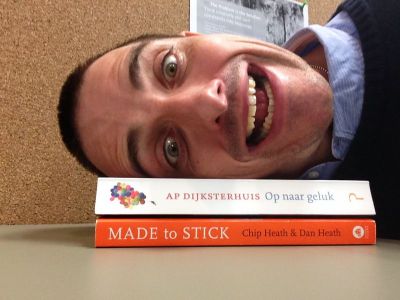
(over hoe geluk blijft plakken…)
Wat is geluk en hoe kun je dat bereiken? En hoe kun je je ideeën ‘sticky’ maken zodat mensen ze onthouden, geloven en ervoor gaan? Twee thema’s waar ik me in de afgelopen weken lekker in heb kunnen verdiepen door het lezen van de boeken ‘Op naar Geluk’ van Ap Dijksterhuis en ‘Made to Stick’ van de broers Heath. Beide lezenswaardig! En al is het ‘lekker-bij-de-haard-of-onder-de-kerstboom-lees-seizoen’ afgelopen en zijn we weer allemaal lekker druk – toch moeten deze boeken aangeraden worden door ondergetekende.
Laat ik bij geluk beginnen! Ik heb een beetje een haat-liefde verhouding met het begrip ‘geluk’ en ‘gelukkig’. Mensen die ik coach en die zeggen ‘gewoon gelukkig’ te willen worden, geven mij altijd een beetje de kriebels. ‘Gelukkig zijn’ is niet iets dat je gewoon bent – daar moet je hard aan werken. En geluk is niet een soort constante staat waarin je kunt verkeren. Je bent nooit 100% van de tijd gelukkig. Dat zou denk ik ook heel vermoeiend zijn voor jezelf en voor de mensen om je heen.
Dijkesterhuis geeft in zijn nieuwe boek een mooi overzicht van alles wat we weten over geluk en maakt daarbij een combinatie tussen geluk gebaseerd op ‘Westerse’ filosofie en daarnaast op meer ‘Oosterse’ filosofie. Daarbij geeft hij duidelijk aan dat we geluk grotendeels in eigen hand hebben (voor 50%!) – 10% door omstandigheden is en toch nog 40% door je genen bepaald wordt. Hoe zit dat dan? Westers geluk richt zich vooral op het actief beïnvloeden van de inhoud van je bewustzijn – wat kun je dóén om gelukkiger te worden? Geluk is niet de lotto winnen, de grootste auto rijden of beroemd zijn (iets wat in America 80% van de jongeren willen), maar zit vooral in andere zaken – verbondenheid, zinvolle vrijetijdsbesteding, de juiste doelen stellen. Oosterse geluk richt zich daarentegen op het controleren van je bewustzijn om zo je gemoedsrust te vergroten – dat kun je trainen (o.a. door meditatie) en zo aanleren afstand te nemen van de 100.000 gedachten die je dagelijks opjagen. Tot zover een korte inhoudelijk impressie.
In het eerste ‘Westerse’ deel van geluk is Dijksterhuis scherp, grappig en zet hij een nuttige visie op geluk uiteen. Heerlijk om te lezen. Als hij overgaat op de Oosterse filosofieën, op het trainen van je bewustzijn als gelukvergroter, wordt het allemaal wat vager. Ik zou zeggen dat dit gedeelte van het boek nog niet helemaal af is. En voor mijn gevoel wordt het minder humoristisch. Misschien is ook Dijksterhuis nog teveel bevangen door zijn Westerse achtergrond en moet hij de Oosterse mystiek nog wat meer in de (typ)vingers krijgen. Ondanks dat, een zeer mooi en bruikbaar perspectief op de maakbaarheid van geluk. Zeker voor mensen die zoekende zijn, zal het enig houvast geven, al is het alleen maar omdat uit vele onderzoeken blijkt dat we in Nederland er geluk-technisch gewoon heel goed afkomen. Dus de volgende stap lijkt me een ‘nooit meer klagen’ boek!
Geluksgoeroe worden? Klik hier en bestel via Bol.com
Dan de ‘sticky’ boodschappen… wanneer blijft een idee of boodschap plakken en wanneer ben je het direct vergeten? De gebroeders Heath schreven dit boekje als in 2007, dus hier en daar voelen de voorbeelden al een beetje ‘ancient’, maar de basis blijft stevig ook nu nog overeind: Volg de SUCCES-methode om te zorgen dat je publiek blijft plakken!
Een kort college: De eerste S is van Simple (ik houd het even in het Engels) en betekent dat je ECHT ALLEEN de kern van wat je wilt overbrengen en dat je het qua taal compact houdt (dus geen lange zinnen (mental note to self!)). De U staat voor Unexpected: je trekt de aandacht met iets dat verrassend is… Het voorbeeld dat gegeven is het verhaal van Jared, de Amerikaan die door het eten van Subway sandwiches 111 kilo verloor (only in America!).
Dat is onverwacht… afvallen met fast food! Dus wordt je wel even wakker (intussen is Jared weer aangekomen en is hij veroordeeld voor het bezit van kinderporno… Minder fijne PR voor Subway, maar goed).
De eerste C is van Concrete: Stop met abstracte termen en theorieën en vertaal je boodschap naar een menselijk niveau: Praat het niet over ‘grote groepen vluchtelingen’, maar zoom in op een voorbeeld van 1 klein kind dat alleen naar een vreemd land is gekomen. Noem niet lukraak getallen, maar relateer ze aan iets wat mensen kennen (2 voetbalvelden groot of drie keer van hier naar New York). De tweede C staat voor Credible. En zorg dat je geloofwaardig overkomt. Doordat iemand het verhaal vertelt die een autoriteit is (waar men nog wel vertrouwen in heeft!), of die juist een anti-autoriteit is – de ‘gewone’ mens. Laat ze uit (echte) eigen ervaring vertellen.
E gaat over Emotion. Gebruik emotie in je boodschap en zorg dat het je publiek iets kan schelen. Spreek ze aan op hun belang of op hun (groeps)identiteit. Leuke case: Hoe krijg je ruige Texanen zover om geen afval meer uit hun auto te gooien? Door bekende stoere Texanen (sporters, rockers) te laten zien die roepen ‘Don’t mess with Texas’. Dat raakt iedere rechtgeaarde Texaan diep in zijn of haar opruimhart – hoe durven mensen hun mooie staat te vervuilen! De laatste S is van Stories: vertel verhalen in plaats van het opsommen van feiten en argumenten. Laat mensen meeleven, meedenken en zet ze aan tot actie. Mensen onthouden verhalen – veel minder de specifieke feiten. De overbekende voordelen van storytelling.
Het boek van de Heath’s staat vol nuttige tips, mooie cases en is heel prettig geschreven. Daarmee is het een bron van herkenning en haakjes voor communicatieprofessional op zoek naar een goed verhaal voor hun klant. Ik gebruik het nu als de basis voor een kleine training over het verbeteren van communicatieboodschappen. Er zijn ook nog allerlei resources gratis online beschikbaar, dus je kunt lekker los!
Zin in dit boek? Bestel door hier te klikken voor maar iets van 12 euro!
Maar… eh… even terug naar de ondertitel van deze review, die was toch ‘over hoe geluk blijft plakken’? It’s easy: door eerst het boek van Dijksterhuis te lezen weet je precies hoe het zit met geluk. Vervolgens deel je dat met je partner, vrienden, collega’s, klanten, wie dan ook, op een SUCCESvolle manier zodat het maximaal blijft plakken. Spread the word!
Something to sink your teeth in: Your future!
Totally interesting book (with positive perspective!) on a changing world you are a part of.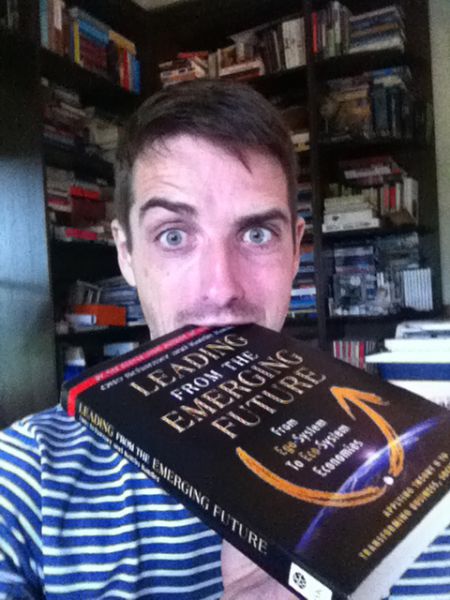
You must have had the same conversations with people around you in the last weeks as me. We see thousands of refugees, with their life packed in one bag, looking for a place they can rest, feel safe and maybe think about a future again. It’s a huge, difficult, complex, human, societal, political and economical issue without a straight answer.
Since we’ve been traveling this week through Germany, Switzerland and Italy, and talked to friends there as well, I have realised even more how this is a European problem, where we have to strive for collective solutions – as countries, as humans.
But do I have the answer? No. It sometimes depresses me a bit – after years of hearing how messed up the economy is, how bad the shape of our environment, you sometimes wonder if there is no positive perspective on these things.
At the same time I was reading the book ‘Leading from an emerging future’ by Otto Scharmer and Katrin Kaufer – both connected to the Massachusetts Institute of Technology (MIT - a leading uni in the world). Without completely outlining the content of the book (cause of course you should read this yourself!), it describes the development of our society (government, economy, technology, environmental, leadership, etc.) and the big changes in it over the years – think about the industrial revolution, globalization, but also the before mentioned banking crisis and the growing divide between rich and poor. And it shows you the way we ‘handle’ those things.
The important message Scharmer and Kaufer are delivering, is that changes in the world need changes in the way we look and deal with it. You cannot solve today’s problems (like thousands of refugees moving into Europe) with the ideas, structures, institutes and attitudes we have had over 40 years.
What I mainly like about the book, is how it talks to you as the reader, being part of this current period of change, and handing you a perspective to look at the world of tomorrow.
To summarize it shortly, this perspective is one that moves from an Ego-driven system to a more Eco-driven economy. In our Ego world we are focused on owning commodities (like land, raw materials, consumptions good), we sell our own labour for money to mass consume what we want (and not so much need..). Markets and competition rule the world. To be honest, this has brought me a lot personally… I live very well, am educated, eat and drink properly, live in a warm nice house, travel, etc. But it has brought the majority of the world much less than that.
This new perspective that is sketched in the book is already happening, and I happily realised I’m part of that too! We need to go into a more co-creative world, where we focus more on shared access to services and resources (instead of private), more co-creative use of our own personal assets (like the labour we offer) and the combination of social and business entrepreneurship – doing things that have a real purpose and that matter to more than just yourself. (I’m totally not doing the book justice here with this summary, there is a much richer description available). It also calls upon you to look at yourself – your own role in this, the way you work, buy, live, share, etc. Like I said, I realised being an entrepreneur myself over three years, how much more I use my creativity in working together with different people for different and new clients. I also see – with a lot of my clients – how new challenges in their playing field cannot be solved wearing yesterday’s glasses. Everyone is struggling with it, but through reading this book I feel much more empowered to suggest new ways of looking at these struggles now:
- Not just ‘talking’ to the customers and stakeholders of my own clients, but actually inviting them, listening and involving them in new concepts and solutions.
- Not just saying that you are focused on your customers, but organizing your whole company around their word and the issues they face – for instance in healthcare. A care customer is not just one disease or handicap, but a whole person with a family, neighbourhood, colleagues, etc.
- Challenging everyone to come out of their offices, structures, boxes and making them look at themselves, their real purpose (besides making double digit growth) and co-responsibility for a bigger picture.
These are just a few of the things I’m eager to apply with the clients I work with. You will surely find your own new insights to use!
How about the refugees now? Yes, there should be a European wide approach to this. Yes, we should find place for these people in our countries and make them feel safe and valued again. And we should ask them what they want and need and think they can do. Not just tomorrow, but also in the longer term.
What can I do about this myself? I can gather everything in my house that these people need and I hardly even notice anymore. I can volunteer and support (the Red Cross needs a lot of extra help and money) and I can listen and speak my mind, especially towards the ones who think these people are coming here to take their job, rape their children or make us all Muslim. This is not just the problem of my government or country, but also of me as a part of that. In the mean time: Please all read this book and transform with it.
What is your WHY?
Of course I had heard about Simon Sinek’s Golden Circle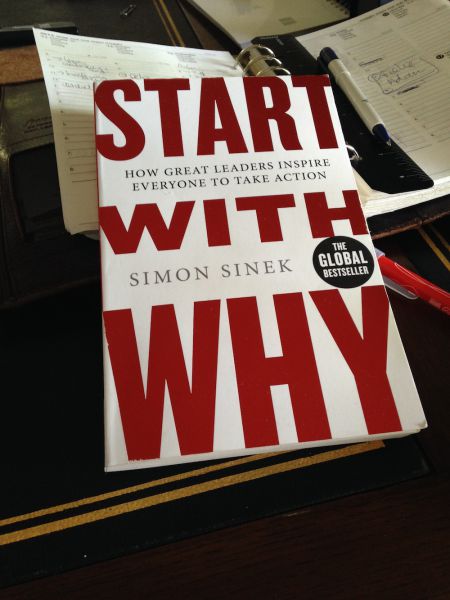 and I have seen his great Ted Talk online (You haven’t! Shame on you – check it out on: https://www.youtube.com/watch?v=qp0HIF3SfI4).
and I have seen his great Ted Talk online (You haven’t! Shame on you – check it out on: https://www.youtube.com/watch?v=qp0HIF3SfI4).
But this was already a number of years ago and in my mind his Golden Circle was mainly a communication tool that could easily be used in key messages. But lately I have actually read Simon’s book (“Start with Why”), and I have realised it is SO much more!
This ‘Why’ is something we should all be wondering about - every day - with everything we do. It’s not just a communications model, but it could be the basis of a thriving business and, even better (and interesting for me as a coach), the basis for a fulfilling personal existence. I will tell you why I am so excited!
The model looks pretty straightforward:

Three circles with Why, How & What. Easy to remember right? But what does it mean?
The ‘What’ on the outside is about results – these are the products or services a company offers, or, if the golden circle is about you as a person, your concrete behaviour – the things we see you do!
The ‘How’, in the next circle, is about structures and processes. The rules a company follows and the way they organise their work for instance. How they make things (happen). For a person it would be your personal values you stick to. How you approach work, relationships, etc.
The ‘Why’ in the middle is, according to Mr. Sinek, the true reason people buy from a brand or company. We buy from Apple because they challenge the status quo in everything they do and reshape business models (think Iphone, think music industry and Itunes) – they do things different and we like that, because it makes us feel different and special too. For an individual the question is why are you here? What is your goal or purpose in life – no – not the one your parents or spouse invented for you – the one YOU like!
(Chew on that for a bit)
The book gives more examples of how the circle works and it’s a nice and easy read. Critial note: there is a LOT of Apple going on and I would have challenged him to come of with some more diverse examples. And the book has a lot of repeats (the way Americans like to hammer their gospel in to you ;-)) But I guess that’s how we learn.
But – coming back to why you should REALLY read this - the most powerful part of the book is saved for last. It’s the story about Ben Comen. I have copied it down below for you to read. Please do, because I hope it inspires you too!
It tells you how to be successful as a company, but in my opinion, it also tells you how to be successful as a human being. By knowing what your own personal “Why” is – no matter who you are, how big or small, rich or poor, clever or not so clever, etc. And by communicating that why to others. In coaching a lot of what we do is finding people’s Why or getting them back on track with their Why’s. And it’s when clients (re)connect with their Why, when the magic happens.
So be brave and share your ‘Why’ with the people around you. It will help you to better take decisions, in your work, relationships (on who you date), where you spend your money and how you raise your kids. It will give you energy in the morning when you get up and a sense of fulfilment in the evening when you think about your day.
Read this book and think about your own Why. Test your Why(s) with your partner, your friends or colleagues and see what they think! Cause if everyone knows what you are about, you will gather people around you that understand and support you in your Why. And you help others in living their ‘Why’s’ as well. How cool would that be! ;-)
Have fun reading and hire a coach if you want to find out WHY for yourself!
From: Simon Sinek, Start with why:
BANG!” The gun fires and the race is on. The runners take off across the field. It rained the day before and the ground is still damp. The temperature is cool. It is a perfect day for running. The line of runners quickly forms a pack. Like a school of fish they come together as one. They move as one. The pack sets a pace to maximize their energy for the whole race. As with any race, in a short period of time the stronger ones will start to pull ahead and the weaker ones will start to fall behind. But not Ben Comen. Ben was left behind as soon as the starter gun sounded. Ben’s not the fastest runner on the team. In fact, he’s the slowest. He has never won a single race the entire time he’s been on the Hanna High School cross-country track team. Ben, you see, has cerebral palsy.
Cerebral palsy, a condition often caused by complications at birth, affects someone’s movement and balance. The physical problems endure for a lifetime. Misshapen spines create a twisted posture. Muscles are often withered and motor reflexes slow. Tightness in the muscles and joints also affect balance. Those with CP often have an unsteady gait, their knees knock and their feet drag. To an outsider, they may seem clumsy. Or even broken.
The pack pulls farther and farther ahead while Ben falls farther and farther behind. He slips on the wet grass and falls forward into the soft earth. He slowly picks himself up and keeps going. Down he goes again. This time it hurts. He gets back up and keeps running. Ben won’t quit. The pack is now out of sight and Ben is running alone. It is quiet. He can hear his own labored breathing. He feels lonely. He trips over his own feet again, and down he goes yet another time. No matter his mental strength, there is no hiding the pain and frustration on his face. He grimaces as he uses all his energy to pull himself back to his feet to continue running. For Ben, this is part of the routine. Everyone else finishes the race in about twenty-five minutes. It usually takes Ben more than forty- five minutes.
When Ben eventually crosses the finish line he is in pain and he is exhausted. It took every ounce of strength he had to make it. His body is bruised and bloodied. He is covered in mud. Ben inspires us, indeed. But this is not a story of “when the going gets tough, the tough get going.” This is not a story of “when you fall down, pick yourself up.” Those are great lessons to learn, without a doubt, but we don’t need Ben Comen to teach us those lessons. There are dozens of others we can look to for that, like an Olympic athlete, for example, who suffered an injury just months before the games only to come back to win a medal. Ben’s lesson is deeper.
Something amazing happens after about twenty-five minutes. When everybody else is done with their race, everyone comes back to run with Ben. Ben is the only runner who, when he falls, someone else will help pick him up. Ben is the only runner who, when he finishes, has a hundred people running behind him.
What Ben teaches us is special. When you compete against everyone else, no one wants to help you. But when you compete against yourself, everyone wants to help you. Olympic athletes don’t help each other. They’re competitors. Ben starts every race with a very clear sense of WHY he’s running. He’s not there to beat anyone but himself. Ben never loses sight of that. His sense of WHY he’s running gives him the strength to keep going. To keep pushing. To keep getting up. To keep going. And to do it again and again and again. And every day he runs, the only time Ben sets out to beat is his own.
I’m not here to make you comfortable.
 I love coaching.
I love coaching.
I love to coach.
I love being coached.
I love the insights coaching gives to clients and the changes it brings them.
I love the feeling I get when I know things are shifting for myself.
You know what they say: Life is a journey…. It’s such an open door. Yet SO true!
And coaching can help you to make that journey more interesting, somewhat easier or maybe just a tad more difficult. But it will certainly give you the feeling you are living your life.
Last week I realised again how much of a craft coaching really is and what it means to be a good coach. I was in the presence of a group of other coaches for training and we had a very wise and experienced coach give us a great insight: ”As a coach, you are not there to make you client feel comfortable!
Sounds off? Let me tell you why it’s spot on!
Part of our job as coaches is very often to explain what coaching actually is. Let me share three common prejudices about coaching that are NOT true and tell you why (and all of this for FREE!).
NOT TRUE #1: Coaching is for people with problems
When I talk to people – for work, but also in private – and we are discussing things happening in their lives, I often ask them if the have a coach. A lot of the times I get answers like: “I can handle this problem myself”, or “I don't need therapy” or the simple “Why?”. Apparently you can only have a coach when you are in deep trouble. NO!
Coaching is not (just) for people with problems of issues they are stuck with. It is for everyone who wants to keep his or her life moving and is looking to see where and how things can become even better. So you don’t have to be desperate to get coached or have a big pressing question to answer. You can just be curious about what else is possible. Positive things can be a topic just as well and coaching can get you to look at things from all sides and appreciate them even more.
The other thing is that good coaches focus on the person in front of them, not just on a specific problem or question. We coach a whole person not just that little part called ‘my talk with my boss about my salary increase (I did not get)’. So even if you come in with a topic around your work, we might end up talking about your relationship with friends or the way you spend your free time. If you say “That has nothing to do with it” or “I can really separate that”, I will know you are lying.
Our lives these days are so complex and intertwined, it is impossible to separate things and ‘only’ look at one topic and ignore all the other things that are going on in your life. If you started the day again with a fight at home, you’re not going to walk into that breakfast meeting as Mr. Sunshine… And maybe you are working so hard, because you have lost your connection with your partner? Or what if you take your frustrations at work out on your innocent patient and lovely friends!
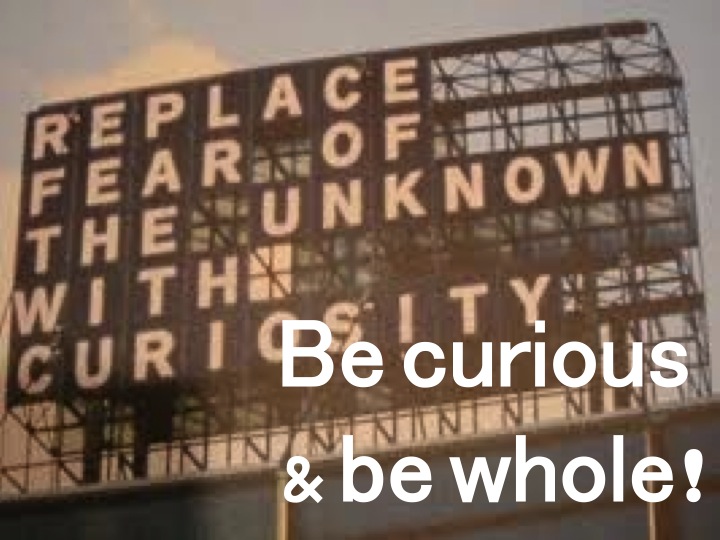
NOT TRUE #2: Coaches provide solutions
Since I am also a consultant, my biggest learning becoming a coach was NOT trying to ‘fix’ people and come up with all the answers and scenario’s for their questions. As a consultant, that is what you are paid for: You give your client answers, preferably a choice, and implement accordingly. As a coach, you don’t. The truth behind this is that the answers are always in the clients themselves.
A coach sees his or her client as resourceful, creative and whole – meaning clients very often know what to do, but just need help to formulate it, say it out loud and act on it. Coaches can trigger just that. But they won’t tell you what to chose or do. And we don’t do it for you! You have to start moving. Not the coach! As a client you are master of your own success in deciding what you are going to act on and when. And the biggest learning for clients happens not so much during the coaching session, but in between sessions, when they are ‘out there’ with their challenge in mind.
Sometimes it’s just an inquiry they are thinking about. Sometimes it’s a very clear task they have set themselves. When they return, they have to share with their coach what happened. And even when they have failed, or have not done their task, they very often thought about it, learned something and something was stirred anyway.

SO NOT TRUE #3: Coaching is just a nice chat
I have a friend who told me about his coach. She was such a nice middle-aged lady with whom he chatted every two weeks for two hours over tea. They discussed how he was doing (thank God), if he took up boxing as she had advised him and also about the renovations to her house and the things she was busy with. She drew his horoscope, which he thought was a bit weird, since he did not ask for it, and it was all very cosy. Like you are visiting your lovely auntie on a Sunday afternoon.
My question was what had changed for him after a number of sessions. He didn’t know. He actually thought it was all kind of useless, but she was such a sweet lady, that he would just sit out his number of appointments and did not date to quit.
To be honest, that pisses me off. I hear this a lot. Everyone can call him- or herself a coach and so they do. I have talked to ‘coaches’ who ran nail-studios before, but since they could ‘chat so nicely’ with customers, decided to also ‘be a coach’. You don’t just wake up one day and decide to be a coach. You need to be trained to coach and you need to stick to certain rules that will bring your client real results. And you need tons of experience as a coach and to keep on learning yourself. All the time! So always ask what kind of training your coach has had and asks for certificates!
Besides, as a client you should feel things are happening for you. Like I said before, the coach is not going to do it for you – but your sessions and your homework should get things moving. I was trained at CTI and there all coaches are taught to coach for nothing less than a transformation in their clients.
Meaning they are eager to work hard with their clients in the sessions and are really committed to getting their clients out of comfort zones, limiting believes or stuck emotions. And as coaches we are trained in the tools to evoke that transformation. We learn to champion our clients and to hold the space for them to experiment in a respectful and safe way. We challenge them, but we don’t slaughter them. We will walk on the edge with them, but we will never let them fall down on their face. And when transformation happens, after two, five or ten sessions, we will acknowledge the success of our clients and their bravery and energy.
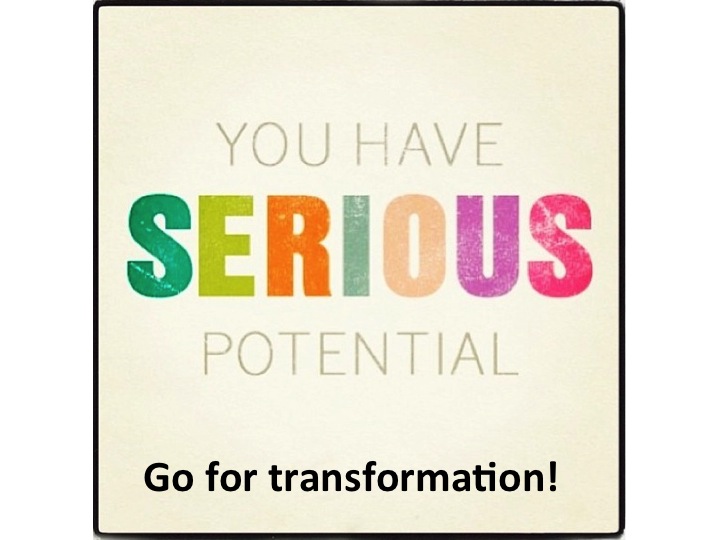
I truly wish everyone would allow themselves a coach and get that feeling of someone challenging them and being ‘with’ them on their journey. But coaching is not for pussies. That is what we mean when we say we are not there to make you feel comfortable.
Being your own Energy-Booster (also for goal-oriented-rational-non-softies)
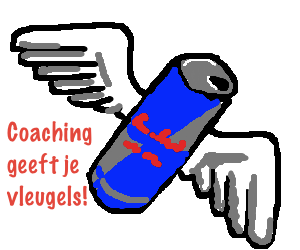 How many times a year do you have this ‘I-love-my-job’ feeling? …. (think)….. Got it?
How many times a year do you have this ‘I-love-my-job’ feeling? …. (think)….. Got it?
How many times a month? A week? A day?
Or maybe you have no idea what I’m talking about… (Click through to emergency coaching NOW! ;-))
I love my job whenever a coaching client is obviously energized after our session. When he or she feels powerful and strong and leaves full of ideas and actions. It is even better when they return a couple of weeks later, still maintaining pieces of that energy. This happens more and more (thank God!) and is just as much of a victory for me as it is for the client.
How does this work? And it this ‘spiritual’ magic performed by me – the great magician/ coach - or vague softy stuff where you have to connect to your inner child?
NO!
In my training as a coach, I learned a MAJOR lesson that has really improved how I can help clients with their question and find their own solutions.
The ‘formula’ seems simple: Focus on where the energy is.
How do I ‘find’ this energy in my clients? By being very curious about their work and life and by listening and looking very carefully. Energy is where they start talking al little bit faster and enthusiastically about something and use more imaginative but understandable language. It is where they sit straight up, their eyes light up, a smile shines through and they use their hands to explain a point.
All I do keep that energy alive by asking more and deepening questions: “How does working in your perfect company makes you feel? What does your perfect family-life look like? What happens when you are totally relaxed? Describe it to me.”
The most important lesson I learned during my coaching-training, was not to fall into the trap of the ‘saboteurs’, popping their ugly head up in the clients mind: “Of course I could never leave my current horrible job and start my own business, because I have to provide for my family”. I would immediately sympathise and understand: Poor client. All these nice ideas and great energy, but hey, his family needs him! How can we first guarantee security for his family before even thinking about him being entrepreneurial?
The saboteur is where the client gets stuck, I get stuck and where the energy is sucked out of us in a blink of an eye. And why? Because the saboteur is that little repeating voice that keeps telling us what we can’t do. But coaching is not about solving that particular problem. Or me having a ready-made-easy-to-implement solution for that very reasonable need for family security. Coaching is about strengthening the client in his energy to get the things he really wants to achieve and finds truly important. And with that powerful energy he will figure out a way to solve the obstacles he comes across on the way.
So we do not focus on the topic of securing family security: Focusing on the topic of creating a company the client believes in and wants to work hard for, will bring that security and probably a lot more. A happy wife and children (“He is SO much more fun when he comes home”), engaged employees (“He’s so inspirational to work with”) and satisfied customers (“He delivers. Always”). Magic? Nopes? (Hard) Work? Yes!
The funny thing is that being a psychologist I should have totally lived by this rule of focusing on the energy already! I know that one of the key basic needs of all humans is to feel positive about themselves. We need this to keep us going, to get up in the morning and to have a purpose. Positive energy is our fuel. People that do not feel positive about themselves (who are depressed) become inactive: They want to lie in bed, covered up, and shut everything and everyone out.
Feeling good about ourselves gives us energy. That is why, when psychologist measure people’s self-image, they always find that people are overrating themselves. This is called the ‘Better than average-effect’: People claim they are better drivers, cooks, soccer-analyst, mother, friend, etc. But they can’t all be better, cause that would mean average would not exist. But it’s healthy to overrate yourself a bit! I do it, you do it!
The hard thing is to keep the focus on the positive and the energy and not get distracted by all the sabotaging thoughts that you (and others, who are happy to help with that!) can list. So see where your energy takes you, it is probably more fulfilling and FUN!
And if you need some assistance in finding your energy and in keeping it up: Find a (good) coach to help you on your way! Check out www.gaycoach.nl or www.diederikconrad.nl